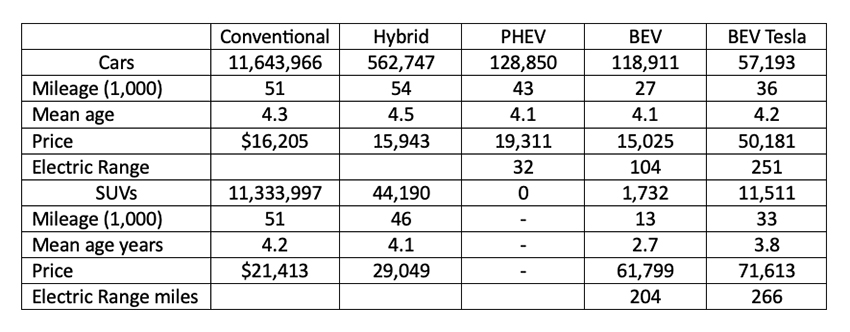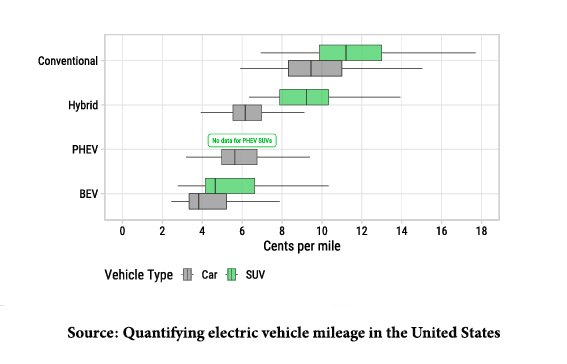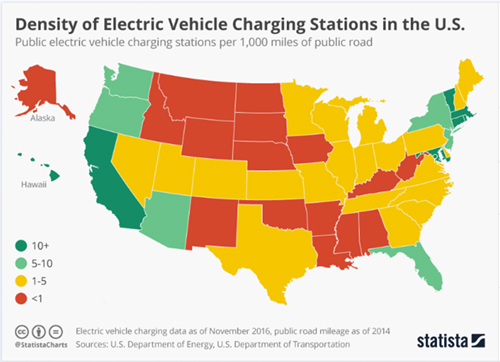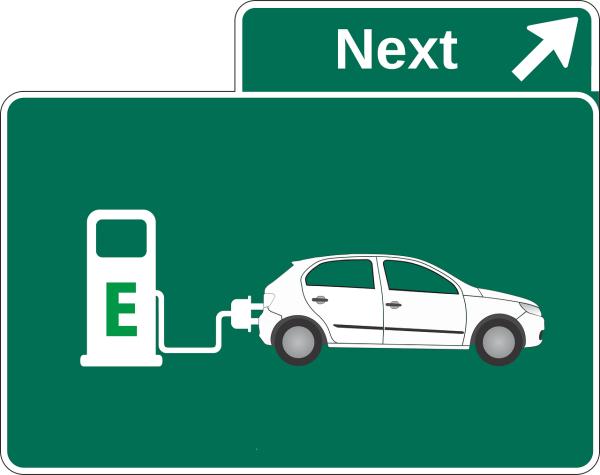Determining vehicle miles traveled ideally comes directly from odometer readings. Data collected from the federal National Household Travel Survey suggested that plug-in EVs logged about two-thirds of the miles of CVs. Calculations based on changes in home electrical usage found VMTs of 6,700 annually. And another small study using those odometer measures suggested that BEVs logged 12,522 miles annually.
The current research used odometer readings collected from dealerships on used vehicles with various powertrains, conventional and hybrid, including plug-in models (PHEV) and battery EVs (BEV), between 2016 and 2022. Here is the underlying dataset of used vehicles for sale.

 Interestingly, there currently are no electric pickup trucks, which represent about 20% of used car purchases, and no plug-in hybrid SUVs, which generally represent 40% of that same market.
Interestingly, there currently are no electric pickup trucks, which represent about 20% of used car purchases, and no plug-in hybrid SUVs, which generally represent 40% of that same market.
BEVs, particularly non-Tesla models, accumulate about 39% fewer miles annually than CVs, HEVs, and PHEVs, which all drove about the same VMTs. Tesla BEVs show slightly higher annual mileage but still 25% less than CVs. In short, PEVs were driven less.
Other data explorations found that VMTs increased as the electric range increased, but more for those cars with the lowest baseline electric range, suggesting that the gap between the VMT of conventional and electric vehicles cannot be fully resolved by simply increasing range.
Electrics were significantly less expensive to drive. [1] Owners of BEVs show less sensitivity to changes in  operating costs compared to CVs and other powertrains. A one-cent increase reduced their VMT by 59 miles annually; for conventional cars, that reduction was 140 miles annually. For the econ nerds amongst us, this suggests greater price elasticity for electrics. Still, when those mileage changes are compared to annual miles driven, there is little elasticity – we do not have as many “discretionary” miles on our vehicles. Prior research indicates that drivers are more responsive to gasoline prices than electricity prices, possibly due to the visibility of changing gas prices.
operating costs compared to CVs and other powertrains. A one-cent increase reduced their VMT by 59 miles annually; for conventional cars, that reduction was 140 miles annually. For the econ nerds amongst us, this suggests greater price elasticity for electrics. Still, when those mileage changes are compared to annual miles driven, there is little elasticity – we do not have as many “discretionary” miles on our vehicles. Prior research indicates that drivers are more responsive to gasoline prices than electricity prices, possibly due to the visibility of changing gas prices.
“Models that assume equal substitution between BEV and CV usage are implicitly assuming an optimistic scenario that is inconsistent with historical usage.”
The research does not indicate why electrics are not used as much as conventional vehicles, but certainly, one factor is range anxiety. Given the current range of battery electrics, I can quickly go from my home to New York City, but I certainly could not go from Philadelphia to Pittsburgh. (Why I might want to make that drive is unclear). To make that longer drive, I would have to “fill up.” While filling a gas tank may take a few minutes, adding 200 miles to my electric range, even with a Supercharger, takes about 15 minutes. Of course, that assumes a nearby charging station.
 As you can see from the map, the mid-west is a charging station “desert.” For electrics to achieve their potential, there is much infrastructure to build. As the use of gasoline declines, so will the need for gas stations, and entirely removing those underground gas tanks will be a cost someone, meaning us, will have to absorb.
As you can see from the map, the mid-west is a charging station “desert.” For electrics to achieve their potential, there is much infrastructure to build. As the use of gasoline declines, so will the need for gas stations, and entirely removing those underground gas tanks will be a cost someone, meaning us, will have to absorb.
The lower VMTs of electrics suggest a selection effect is at play; early BEVs were purchased by individuals with lower annual mileage needs. Additionally, the study suggests that the majority of early BEV adopters owning more than one vehicle may choose to drive their BEV less, using their second conventional vehicle for distance driving.
Assuming equal mileage between conventional and electric vehicles overestimates EVs’ impact on a cleaner, fossil-fuel-free environment. It may well overestimate the needed electric infrastructure, although that may well be a chicken vs. egg problem as vehicle range and its attendant anxiety dampen the conversion to BEVs
[1] Fun fact. When renting a fossil fuel car, you must return it with a full tank or pay an $8.00 refueling fee along with the cost of gasoline. For an electric, the battery need only be charged to 10% upon return
Source: Quantifying electric vehicle mileage in the United States Joule DOI: 10.1016/j.joule.2023.09.015




